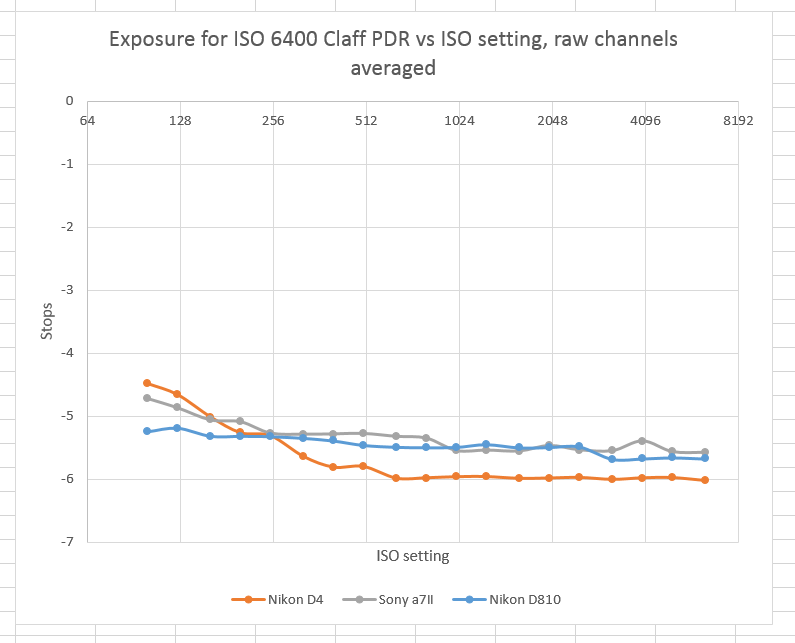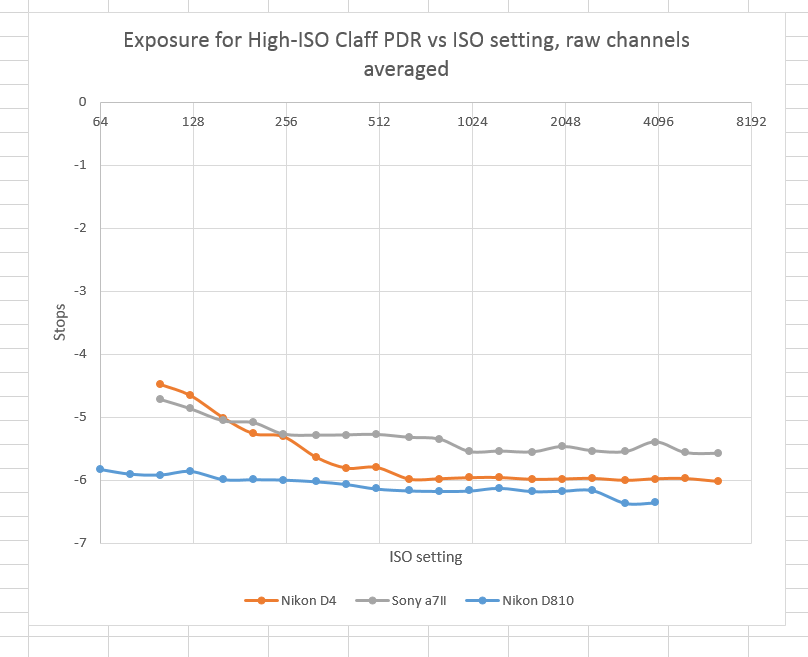I left off yesterday’s post with two questions about comparing shadow noise performance of cameras with different resolutions:
What should we pick for a common resolution, and what value should we pick for a barely-acceptable SNR?
Thinking that I couldn’t be the first person to ask these questions, I thought to look around to see what others had done with this issue.
I didn’t have to look far; Jack Hogan gave me a pointer.
Bill Claff is a well-known sensor analysis expert, although that’s not his day job. I’ve used the term Photographic Dynamic Range in this blog often, defining it loosely as the ratio of full scale over the mean value that produces a signal to noise ratio (SNR) of about 10, Bill uses the same term, has come up with a definition which allows all camera resolutions to be fairly compared.
Bill’s definition of the SNR that forms the denominator of the dynamic range ratio is 16000 over the camera image height in pixels. That sounds arbitrary, but it’s not.
Well, it’s a little arbitrary. Let’s get that part out of the way first. It ignores aspect ratio. I’m going to modify the SNR floor to 28844 over the image diagonal in pixels. That will give the same number for images with 2:3 aspect ratios. It’s way more significant digits than we need for this calculation, but, what the heck, computers are going to do all the work anyway, and they don’t care.
What setting the SNR floor for a raw image to 28884 over the image diagonal in pixels does is produce an SNR of 20 for landscape oriented images ideally resized to 8 inches high and viewed at arms length. You may print larger and you may view the image from a different distance. In that case, you’ll want to adjust the floor SNR accordingly.
I’ll help you with that in a later post. First I’m going to do something that Bill was too modest to do himself. I’m going to rename his dynamic range to Claff Photographic Dynamic Range (CPDR). My reason to so, aside from giving credit where credit is due, is to make it clear which photographic dynamic range I’m talking about, since I and others have used the term Photographic Dynamic Range with different definitions than Bill’s. While we’re at it, lets agree to call the SNR that defines the bottom of the CPDR the Claff SNR.
So now I need to do a little math.
I’m back. I’ll spare you the calculations, but the answers are:
- For the a7II, the Claff SNR is 4.
- For the D4, the Claff SNR is 4.9.
- For the D810, the Claff SNR is 3.3.
That’s with all the cameras set to full frame mode. Now we can make some comparisons. For the same ISO range, the signal required to reach the Claff SNR in stops down from full scale looks like this:
Lower lines are better. Remember, as the ISO goes down from ISO 6400, the exposure is not changed, so to achieve the same mean values requires more and more pushing in post-processing. Note also that that’s a six-stop push for the ISO 100 points.
In one sense, the chart is not fair to the D810, because its base ISO is two thirds of a stop below the other two cameras, but in another sense it is because the defining exposure is at ISO 6400 for all three cameras.
If we say we want to compare the three cameras over the six binary orders of magnitude above their base ISO, we get this:
That’s not really fair to the D4 and a7II, since the D810 gets two-thirds of a stop more light.
I’m not really sure how to deal with this base ISO discrepancy, but the curves show that the D810 is the most ISO-less, followed by the a7II, and then by the D4. All are essentially ISOless above ISO 640.
By the way, on his web site, Bill expressed some distaste for the term “ISOless”. I share that revulsion, but know of no similar term that simultaneously is widely understood among the photographic digerati, and is any less clunky, So, until something better comes along, I’m going to continue to use it. And, before you ask, I don’t think that “ISO-invariant” is an improvement.


Rick Whitacre says
Fun stuff, Jim! Any idea where the A7S would fall on these graphs? I remember you mentioning that it had some “interesting” attributes as it transitioned from ISO1600 – ISO3200
Thanks!
Jim says
Coming up in a few days. I just finished exposing the images, all 3200 of them!
Tony Field says
since “ISOless” implies “ISO independent”, why not use that term.
Jim says
Not a bad idea. Others now use ISO-invariant. I’ve kinda gotten used to ISOless, by now, though. Since there is some effect except in cameras where all the gain is digital or the ISO knob puts a tag in the metadata, a term with a bit of wiggle room would be nice: “ISO pseudo-invariance”?